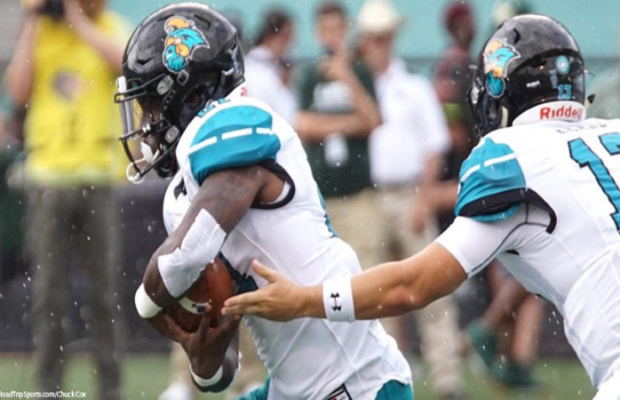Turnovers can be devastating and there can never be enough emphasis on securing the football. Here are just a few of the many drills that prepare our student-athletes for competition.
- Chant Drill
- Monkey Rolls
- Ball Harness
- Rip and Strip Drill
- Ball Catching Drill
Chant Drill
The Chant Drill is used to warm up the running backs. There are three phases of this particular drill.
Phase 1: Measure off 10 yards. You can have your players go two or three at a time, according to the number of backs you have. You can even have them all line up side-by-side and go all at once.
As soon as the whistle blows, start pumping your arms and knees towards your chest while gradually gaining ground over 10 yards. Once you have gone 10 yards, return doing the same thing, pumping your arms and legs, but doing so backwards for 10 yards.
Phase 2: The carioca drill is a cross-stepping movement that propels the body laterally and will help improve lateral movement, agility and footwork.
In the athletic position, push off with the left foot and bring it toward the right foot. While maintaining balance, cross the left foot behind the right foot and plant it on the ground. Move the right foot laterally so you return to the athletic position. While maintaining balance, cross the left foot in front of the right foot and plant it on the ground. Move the right foot laterally so you return to the athletic position. Reverse the steps to perform this drill while moving to the left.
Phase 3: The speed weave drill emphasizes closing space on a defender, lowering your profile (bending the knees) while moving fast, putting your foot in the ground at the defender (cone) and taking a short lateral step to the defender’s up-field arm. The lateral step-out rather than a crossover is essential to handle contact and maintain balance. On occasion in this drill, we put a pursuer starting 3 yards behind the ball carrier. The running back learns quickly there is no time for extra shakes or fakes. Pursuit is coming, so maintain your speed!
Monkey Rolls
A major cause of fumbling is a player’s natural instinct to reach out with his hand to break his fall.
If that happens to be the hand in which he is carrying the ball, he will likely extend his arm and in the process expose the ball, making it more likely to be jarred loose by a tackler or by contact with the ground. Yes, the ground can cause a fumble. The purpose of the Monkey Roll Drill is to get the players used to falling while keeping the ball in contact with the body at four points.
Players A, B and C will line up side-by-side with 2 yards between them. Player B, the one in the middle, starts the drill by rolling to his right. Player A, the one Player B is rolling toward, rolls over Player B. Player B then gets up and prepares to roll back the other way. Player A, meanwhile, will continue to roll until he gets to Player C, who will then roll over. Player A will get up and roll back the other way, first rolling over Player B, who will be arriving on his feet. And so forth. Do this a couple of times. This drill also teaches guys to protect the ball when they fall.
Ball Harness Drill
Take a ball and place a harness over the ball. The harness has an elastic strap attached to it. The first part of the drill is to pair your running backs up and have one of the running backs tuck the ball away.
His partner will hold the strap and, while jogging 3/4 speed, try to pull the ball out from partner for about 20 yards. Switch arms coming back. Switch positions and repeat the drill.
Rip And Strip Drill
This is another drill we do at Coastal to help prevent fumbling. Protecting the football, to me, becomes a pride thing. The football is the most important thing on the field and everyone wants it, even the coaches. Fumbles are not accidental; they are preventable. The Rip And Strip Drill is a competitive drill that will help you get that point across. One player is the ball carrier. He is given the ball with the instructions to “fold over it” with “both hands on both point” and “squeeze the ball into the belly.” The defender reaches in and gets his hands on the ball.
At the starting signal, the defender does anything he can to rip, strip, pry or twist the ball from the ball carrier’s grasp. The ball carrier may twist but he may not run away and he may not deliberately go to the ground. If they should happen to fall to the ground, the contest continues. Give them a time limit. Ten or 15 seconds may be enough for your guys at first.
Make it a competition! If the defender strips the ball loose, the ball carrier does push-ups. If the ball carrier hangs on successfully, the defender does push-ups. The goal is to get my runners to buy into my philosophy and the defenders rarely win.
Ball Catching Drill
Have two players stand up, one behind the other. The player in the back will reach around the head of the player he is behind with his arms extended by his face. A third person (coach) will throw the ball at the front player’s face, and the player in back will have to catch the ball in his hands. If the player in back misses the ball, it will hit the front player’s facemask. This drill forces athletes to catch with their hands.
It is an excellent drill for building trust in your players while developing better hands when they are receiving balls.
Read the original article in American Football Coaches Association Weekly.
